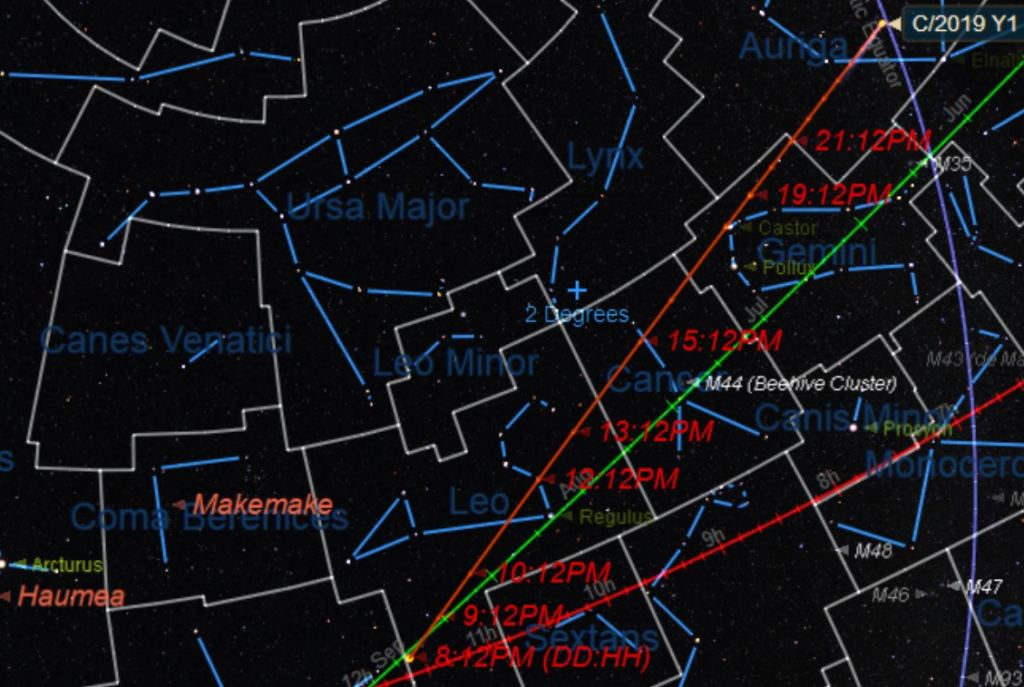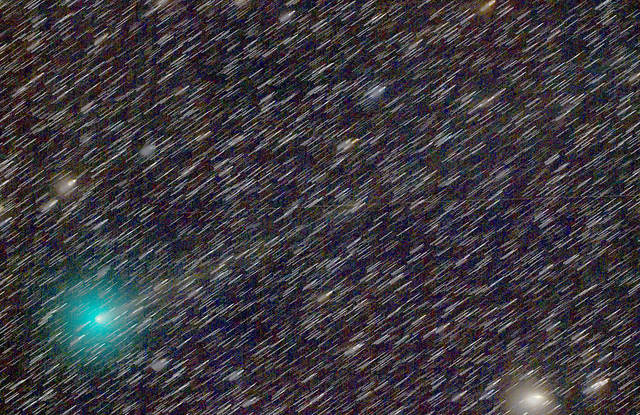Every year produces a handful of binocular comets, and the first one for 2019 is coming right up, with a fine apparition for Comet C/2018 Y1 Iwamoto.
Discovered by Japanese amateur Masayuki Iwamoto as a +12th magnitude fuzzball moving through the constellation Hydra the Water Serpent on the night of December 18th, 2018, Y1 Iwamoto is a fast mover. It’s great to see that amateur astronomers can and still do discover comets, as the robotic competition posed by automated surveys such as PanSTARRS makes such an independent discovery tough these days. And to think, the next generation of really powerful surveys such as the Large Synoptic Survey Telescope (LSST) has yet to come online… I wonder how many hidden comets and asteroids lurk in the latest PanSTARRS data dump?
Stalking the Comet
Part of what makes this apparition of Comet Y1 Iwamoto favorable is its relatively close approach to the Earth. The comet has a high orbital inclination of 160 degrees relative to the ecliptic plane, and reaches a perihelion just 0.282 AU (Astronomical Units) exterior to the Earth’s orbit on the night of February 7th, passing closest to the Earth just five days later. Note: during research, we’ve seen a few days spread noted for perihelion on this one. This is probably due to older dates quoted from early observations of the comet, which tend to be sparse and not as accurate. For this post, we used the most recent 44 day observation arc listed by NASA/JPL.
Comet Y1 Iwamoto is also on a 1,371 year orbit, which will bring it back to the inner solar system in 3390 AD. The comet reaches aphelion at 245 AU, far out beyond the Kuiper Belt in the realm of Extreme Trans-Neptunian Objects, near the aphelion of 2010 VZ98. Its last passage through the inner solar system was around 648 AD and went unrecorded. I always wonder: how many comets snuck past human eyes, before the invention of the telescope? Comet Y1 Iwamoto was one such fleeting ice ball that got away… until now.

2019: Prospects for the Comet
Early February 2019 sees Comet Y1 Iwamoto race up from below the Bowl of Virgo asterism, into the constellation Leo.
The comet sits 30-40 degrees above the SW horizon in the pre-dawn, transiting highest at 40-50 degrees due south as seen from 30 degrees north latitude around 4 AM local through mid-February. The comet reaches opposition on February 13th, crossing into the late dusk sky.
Comet Y1 Iwamoto also visits several photogenic clusters and galaxies along its February path (see the day-by-day listing below) With the Moon currently just past New and waxing, the time to hunt for this comet is tonight and into this weekend, before the fattening Moon adds its light to the evening sky. The Moon reaches Full in February on the 19th.
At its closest on February 13th at 0.304 AU or 28.3 million miles (45.5 million kilometers) distant, Comet Y1 Iwamoto will appear to move seven degrees a day as it crosses from Leo into Cancer. This translates into a fast apparent motion of 20′ arcminutes, or 2/3rds the apparent diameter of a Full Moon, every hour. Watch the comet for about 5-10 minutes and you should notice movement at the eyepiece against the starry background.

Comet Y1 Iwamoto is already at +7th magnitude, and brightening well ahead of predictions. Here’s a dance card for the comet through the peak months of February and March 2019. For the purposes of this ephemeris, “Passes near” denotes a pass closer than one degree in separation, unless otherwise specifically noted.

February
7- reaches perihelion at 1.282 AU from the Sun.
8- Crosses the celestial equator northward.
9- Crosses into Leo, and crosses the ecliptic northward.
10-Passes five degrees from the Leo Triplet.
11- Photo-op: passes near M95, M96 and M105.
12- Passes 3 degrees from the bright star Regulus (Alpha Leonis), and near the +3.5 magnitude star Eta Leonis.
13- Closest approach to Earth at 0.304 AU distant, reaches opposition.
14- Passes near the +9th magnitude galaxy NGC 2903.
15- Crosses into the constellation Cancer the Crab.
16- Passes 7 degrees from the Beehive cluster Messier 44.
17- Crosses into the constellation of Gemini the Twins.
19- Passes near the bright star Castor.
21- Passes near +3.6 magnitude star Theta Geminorum.
22- Passes into the constellation of Auriga the Charioteer.
28- Passes between the Open Cluster M36 and M38.

March
1- Crosses the galactic plane southward.
16-Crosses into the constellation Perseus the Hero.
30- Drops back below magnitude +10.

Comets usually resemble small fuzzy patches at the eyepiece, looking like an unresolved globular cluster that refuses to snap into focus. Binoculars are our optics of choice for sweeping up comets brighter than magnitude +10, and be sure to search out dark skies in your comet quest. Observers are already reporting a small spiky tail for Comet Y1 Iwamoto. We may also see the comet perform a slow motion “tail flip” from our Earthly vantage point, as it crosses opposition in mid-February and seems to begin casting back its dust-tail from the west to the east. Strange but true: as solar wind pressure blows the dust tail of a comet back away from the Sun, a comet can cast its tail ahead of it as it heads back out of the solar system.
A great start for Astronomy in 2019, for sure. And don’t forget Comet 46P Wirtanen, going but not completely gone of off its 2018-2019 apparition. And that next Great Comet of the Century? Well, it’s out there, awaiting that robotic (or perhaps amateur) observer to sweep it up… then the real excitement begins.

